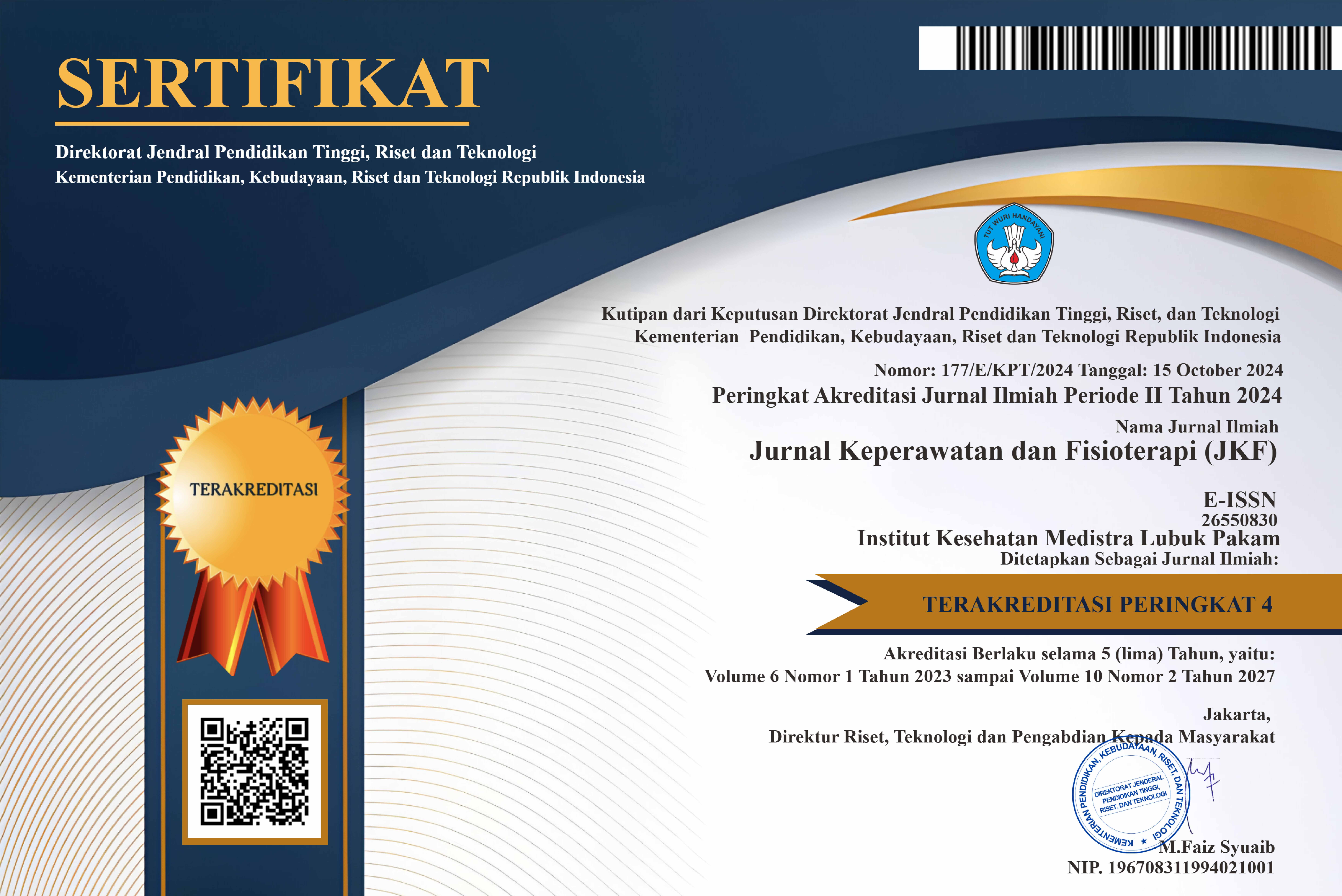The Influence Of Swallowing Exercise On The Ability To Swallow In Stroke Patients With Dysphagia
DOI:
https://doi.org/10.35451/jkf.v5i2.1678Keywords:
Stroke, Dysphagia, Swallowing Exercise, Ability to SwallowAbstract
Signs and symptoms that can be seen in stroke patients are difficulty chewing and swallowing food, coughing, and food often getting stuck in the throat. This event is often called dysphagia. Stroke patients who experience dysphagia amount to 37% to 78%. The effects of dysphagia cause several disease complications that aggravate the patient's condition such as: malnutrition, dehydration, pneumonia, and death. The purpose of this study was to determine the effect of swallowing exercises on the swallowing ability of stroke patients with dysphagia at Grandmed Lubuk Pakam Hospital in 2023. The research method uses a quasi-experimental (one group pretest-posttest design) with 20 respondents. Consecutive sampling is a technique used in sampling. The intervention given to each respondent was in the form of swallowing exercises for 10 sessions. Initial screening for dysphagia was carried out using an observation sheet from the nursing bedside swallowing screening, while the Mann Assessment of Swallowing Ability (MASA) instrument was used to assess the level of ability to swallow. The results of this study indicated that the average mean swallowing ability increased after being given the intervention and found differences in swallowing ability before and after the intervention was given with a value of p = 0.000. The conclusion is that the ability to swallow in stroke patients with dysphagia can be overcome by doing swallowing exercises regularly. It is expected that health workers (nurses) are active in teaching or directing patients who experience dysphagia so that complications do not occur in stroke patients.
Downloads
References
Afrida. (2018). Effect of ingesting training towards dysphagia in stroke patients in Haji hospital and Makassar city hospital. Internasional contemporary Nursing Journal, 2(1)13-20
Akai, Masami. (2015). Rehabilitation Manual 30: Dysphagia Rehabilitation Manual. Japan: WHO Collaborating Centre
Alligood, M & Tomey A. (2014). Nursing Theory Utilization & Application, Third edition. St. Louis Mosby: Elsevier
Arreola, et al. (2019). Natural History of Swallow Function during the Three Month Period after Stroke. Geriatrics Vol 42,1-13. doi: 10.3390/geriatrics4030042
Arnold, M., et al. (2016). Dysphagia In Acute Stroke: Incidence, Burden And Impact On Clinical Outcome. Plos One Vol 11, 1-11. doi: 10.1371/journal.pone.0148424
Black, J.M., Hawks, J.H. (2014). Keperawatan Medikal Bedah :Manajemen Klinis untuk Hasil yang diharapkan, Edisi 8. Singapore : Elsevier
Chen, Daniel F. (2017). Dysphagia in the Hospitalized Patient. Hospital Medicine Clinics;6(1):38–52. Available from: https://doi.org/10.1016/j.ehmc.2016.07.004
David G. Smithard. 2016. Dysphagia Management And Stroke Units.US National Library And Medicine. Springer International Publishing. (https://www.ncbi.nlm.nih.gov/pmc/articles/PMC5148787/)Gomes, Andrea. (2022). Swallowing Exercises: UHN Toronto, https://www.uhn.ca/PatientsFamilies/Health_Information/Health_Topics/Documents/Swallowing_Exercises_for_Patients_with_Head_and_Neck_Cancer_Receiving_Radiation_Treatment.pdf
Habibi, M.,Leila, S.,Sharareh., Niakan,K.,Hossein,G.,Erfan Y. (2018). Revalence of Stroke Risk Factors and Their Distribution Based on Stroke Subtypes in Gorgan:A Retrospective Hospital-Based Study—2015-2016. Neurology Research International, Article ID 2709654:1-7. doi.org/10.1155/2018/2709654
Mourao, Aline. et al. (2015). Frequency and Factors Associated With Dysphagia in Stroke. CoDas, 28, 66-70. doi: 10.1590/2317-1782/20162015072
Nastiti. (2012). Gambaran Faktor Risiko Kejadian Stroke pada Pasien Stroke Rawat Inap di Rumah Sakit. Krakatau Medika. Jakarta: Universitas Indonesia
Smeltzer, S., Bare, B. (2013). Buku Ajar Keperawatan Medikal-Bedah Brunner dan Sudarth, Edisi 8. Jakarta: EGC
Tarihoran Y. (2019). Pengaruh Shaker Exercise terhadap Kemampuan Menelan pada Pasien Stroke dengan Disfagia di Rumah Sakit Kota Medan. Medan: Sekolah Tinggi Ilmu Kesehatan (STIKes) Murni Teguh
WHO. (2016). Package of essential noncommunicable (PEN) disease interventions for primary health care in low-resource settings. Geneva: World Health Organization
Downloads
Published
Issue
Section
License
Copyright in each article is the property of the Author.


























